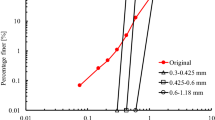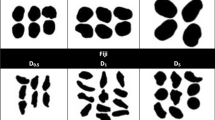Abstract
Particle breakage is a theme of great focus on affecting the behavior of granular soil. This paper presents an experimental investigation on the influence of particle breakage on the isotropic compressibility of the precrushed sands using a number of drained isotropic consolidation tests. Particle breakage resulted in movement of the compression lines followed by the rebound lines towards a decrease in the void ratio, implying that particle breakage caused a more contractive soil. Particle breakage impaired the bulk deformation modulus by increasing the compression coefficient for the compression behavior of the precrushed sands, but showed a complex effect on the bulk deformation modulus and rebound coefficient for the rebound behavior of the precrushed sands. However, particle breakage caused an increase in the compression indexes of the precrushed sands but showed a complex effect on the rebound indexes of the precrushed sands. In the e−p′ plane and the e−logp′ plane, the compression lines and rebound lines of the precrushed sands were curved. A generalized model was proposed to straighten the compression and rebound lines of the precrushed sands in the e − (p′/pa)α plane. Particle breakage resulted in a general rotation and translation of the linear compression and rebound lines of the precrushed sands in the e−(p′/pa)α plane. The critical state line and isotropic consolidation line on the loosest state of silica sand no. 5 were curved in the e−logp′ plane but straightened in the e − p′α=0.7 plane. In the e− p′α=0.7 plane, a reasonable linear critical state line of silica sand no. 5 was proposed by adjusting it to match the isotropic consolidation line on the loosest state.
Similar content being viewed by others
Abbreviations
- a c :
-
Compression coefficient of soil
- a r :
-
Rebound coefficient of soil
- a i :
-
Compression or rebound coefficient of soil, subscript i=c or r
- B r :
-
Relative breakage of soil, Br = Bt/Bp (Hardin 1985)
- B p :
-
Breakage potential of soil (Hardin 1985)
- B t :
-
Total breakage of soil (Hardin 1985)
- CSL:
-
Critical state line of soil
- ICL:
-
Isotropic consolidation line of soil
- C co :
-
Coefficient of curvature of soil
- C i :
-
Compression or rebound index of soil, subscript i=c or r
- C c :
-
Compression index of soil
- C r :
-
Rebound index of soil
- C u :
-
Coefficient of uniformity of soil
- e :
-
Void ratio of soil
- e0 :
-
Initial void ratio of soil
- e max :
-
Maximum void ratio of soil
- e min :
-
Minimum void ratio of soil
- F c :
-
Fines content of soil (%)
- G s :
-
Specific gravity of soil particles
- K 0 :
-
Initial consolidated stress ratio
- K i :
-
Bulk deformation modulus of soil, subscript i=c or r
- K c :
-
Bulk deformation modulus for compression response of soil
- K r :
-
Bulk deformation modulus for rebound response of soil
- p a :
-
A reference pressure
- p′ :
-
Mean effective stress of soil
- SP:
-
Poorly-graded sand (JGS 0051 2015)
- σ c0 :
-
Initial confining stress
- α :
-
A model constant of soil
- λ :
-
A model constant of soil
- Δe :
-
Difference in the void ratio e of soil
- Δe i :
-
Difference in the void ratio e of soil at the i condition
- Δ(i):
-
Difference in the (i), i=(p′/pa), log(p′/pa) or (p′/pa)α
- dε v :
-
Volumetric strain increment of soil
- dp′ :
-
Mean effective stress increment of soil
- Λ:
-
A set of constants of soil
- C A:
-
set of constants of soil
- f():
-
Function of relative breakage Br and a set of constants of soil Λ
- g():
-
Function of relative breakage Br and a set of constants of soi C
References
Altuhafi FN, Coop MR (2011) Changes to particle characteristics associated with the compression of sands. Géotechnique 61(6):459–471. https://doi.org/10.1680/geot.9.P.114
Bandini V, Coop MR (2011) The influence of particle breakage on the location of the critical state line of sands. Soils Found 51(4):591–600. https://doi.org/10.3208/sandf.51.591
Ferreira PMV, Bica AVD (2006) Problems in identifying the effects of structure and critical state in a soil with a transitional behaviour. Géotechnique 56(7):445–454. https://doi.org/10.1680/geot.2006.56.7.445
Guida G, Casini F, Viggiani GMB, et al. (2018) Breakage mechanisms of highly porous particles in 1D compression revealed by X-ray tomography. Geotech Lett 8(2):155–160. https://doi.org/10.1680/jgele.18.00035
Hardin BO (1985) Crushing of soil particles. J Geotech Eng-ASCE 111(10):1177–1192. https://doi.org/10.1061/(ASCE)0733-9410(1985)111:10(1177)
Ishihara K (1993) Liquefaction and flow failure during earthquakes. Géotechnique 43(3):351–415. https://doi.org/10.1680/geot.1993.43.3.351
Jefferies M, Been K (2000) Implications for critical state theory from isotropic compression sand. Géotechnique 50(4):419–429. https://doi.org/10.1680/geot.2000.50.4-419
JGS 0051 (2015) Method of Classification of Geomaterials for Engineering Purposes. Japanese Geotechnical Society Standards: Laboratory Testing Standards of Geomaterials, Vol. 1, The Japanese Geotechnical Society, Tokyo, Japan.
JGS 0111 (2015) Test method for density of soil particles. Japanese Geotechnical Society Standards: Laboratory Testing Standards of Geomaterials, Vol. 1, The Japanese Geotechnical Society, Tokyo, Japan.
JGS 0131 (2015) Test method for particle size distribution of soils. Japanese Geotechnical Society Standards: Laboratory Testing Standards of Geomaterials, Vol. 1, The Japanese Geotechnical Society, Tokyo, Japan.
JGS 0161 (2015) Test method for minimum and maximum densities of sands. Japanese Geotechnical Society Standards: Laboratory Testing Standards of Geomaterials, Vol. 1, The Japanese Geotechnical Society, Tokyo, Japan.
JGS 0520 (2015) Preparation of soil specimens for triaxial tests. Japanese Geotechnical Society Standards: Laboratory Testing Standards of Geomaterials, Vol. 1, The Japanese Geotechnical Society, Tokyo, Japan.
JGS 0524 (2015) Method for consolidated-drained triaxial compression test on soils. Japanese Geotechnical Society Standards: Laboratory Testing Standards of Geomaterials, Vol. 1, The Japanese Geotechnical Society, Tokyo, Japan.
Li X, Dafalias YF (2000) Dilatancy for cohesionless soils. Géotechnique 50(4):449–460. https://doi.org/10.1680/geot.2000.50.4.449
Li X, Liu JK (2021) One-dimensional compression feature and particle crushability behavior of dry calcareous sand considering fine-grained soil content and relative compaction. B Eng Geol Environ 80:4049–4065. https://doi.org/10.1007/s10064-021-02160-2
Ma L, Chiu CF, Cheng YP, et al. (2021) Effects of particle breakage on the compression behaviour of gap-graded carbonate sand-silt mixtures. Geotech Lett 11(1):16–20. https://doi.org/10.1680/jgele.20.00033
Martins FB, Bressani LA, Coop MR, et al. (2001) Some aspects of the compressibility behaviour of a clayey sand. Can Geotech J 38(6): 1177–1186. https://doi.org/10.1139/t01-048
McDowell GR, De Bono JP (2013) On the micro mechanics of one-dimensional normal compression. Géotechnique 63(11): 895–908. https://doi.org/10.1680/geot.12.P.041
Miao G, Airey D (2013) Breakage and ultimate states for a carbonate sand. Géotechnique 63(14): 1221–1229. https://doi.org/10.1680/geot.12.P.111
Mun W, McCartney JS (2017) Roles of particle breakage and drainage in the isotropic compression of sand to high pressures. J Geotech Geoenviron Eng 143(10):04017071. https://doi.org/10.1061/(ASCE)GT.1943-5606.0001770
Murthy TG, Loukidis D, Carraro JAH, et al. (2007) Undrained monotonic response of clean and silty sands. Géotechnique 57(3):273–288. https://doi.org/10.1680/geot.2007.57.3.273
Nakata Y, Hyodo M, Hyde AFL, et al. (2001) Microscopic particle crushing of sand subjected to high pressure one-dimensional compression. Soils Found 41(1):69–82. https://doi.org/10.3208/sandf.41.69
Nocilla A, Coop MR, Colleselli F (2006) The mechanics of an Italian silt: an example of ‘transitional’ behaviour. Géotechnique 56(4):261–271. https://doi.org/10.1680/geot.2006.56.4.261
Pestana JM, Whittle AJ (1995) Compression model for cohesionless soils. Géotechnique 45(4):611–631. https://doi.org/10.1680/geot.1995.45.4.611
Roscoe KH, Schofield AN, Wroth CP (1958) On the yielding of soils. Géotechnique 8(1):22–53. https://doi.org/10.1680/geot.1958.8.1.22
Schofield AN, Wroth CP (1968) Critical state soil mechanics. McGraw-Hill Book, Co., Inc., London, UK.
Shipton B, Coop MR (2012) On the compression behaviour of reconstituted soils. Soils Found 52(4):668–681. https://doi.org/10.1016/j.sandf.2012.07.008
Thevanayagam S, Shenthan T, Mohan S, et al. (2002) Undrained Fragility of clean sands, silty sands and sandy silts. J Geotech Geoenviron Eng 128(10): 849–859. https://doi.org/10.1061/(ASCE)1090-0241(2002)128:10(849)
Verdugo R, Ishihara K (1996) The steady state of sandy soils. Soils Found 36(2):81–91. https://doi.org/10.3208/sandf.36.2_81
Xiao Y, Chen H, Stuedlein AW, et al. (2020a) Restraint of particle breakage by biotreatment method. J Geotech Geoenviron Eng 146(11):04020123. https://doi.org/10.1061/(ASCE)GT.1943-5606.0002384
Xiao Y, Meng MQ, Daouadji A, et al. (2020b) Effects of particle size on crushing and deformation behaviors of rockfill materials. Geosci Front 11(2):375–388. https://doi.org/10.1016/j.gsf.2018.10.010
Xiao Y, Sun Y, Zhou W, et al. (2022) Evolution of particle shape produced by sand breakage. Int J Geomech 22(4):04022003. https://doi.org/10.1061/(ASCE)GM.1943-5622.0002333
Xiao Y, Wang CG, Wu HR, et al. (2021a) New simple breakage index for crushable granular soils. Int J Geomech 21(8): 04021136. https://doi.org/10.1061/(ASCE)GM.1943-5622.0002091
Xiao Y, Wang CG, Zhang ZC, et al. (2021b) Constitutive modeling for two sands under high pressure. Int J Geomech 21(5):04021042. https://doi.org/10.1061/(ASCE)GM.1943-5622.0001987
Yamamuro JA, Bopp PA, Lade PV (1996) One-dimensional compression of sands at high pressures. J Geotech Eng-ASCE 122(2):147–154. https://doi.org/10.1061/(ASCE)0733-9410(1996)122:2(147)
Yan WM, Shi Y (2014) Evolution of grain grading and characteristics in repeatedly reconstituted assemblages subject to one-dimensional compression. Geotech Lett 4(3):223–229. https://doi.org/10.1680/geolett.14.00039
Yang J, Li X (2004) State-dependent strength of sands from the perspective of unified modeling. J Geotech Geoenviron Eng 130(2):186–198. https://doi.org/10.1061/(ASCE)1090-0241(2004)130:2(186)
Yu F (2017a) Characteristics of particle breakage of sand in triaxial shear. Powder Technol 320:656–667. https://doi.org/10.1016/j.powtec.2017.08.001
Yu F (2017b) Particle breakage and the critical state of sands. Géotechnique 67(8):713–719. https://doi.org/10.1680/jgeot.15.P.250
Yu F (2017c) Particle breakage and the drained shear behavior of sands. Int J Geomech 17(8):04017041. https://doi.org/10.1061/(ASCE)GM.1943-5622.0000919
Yu F (2017d) Stress-dilatancy behavior of sand incorporating particle breakage. Acta Geotech Slov 14(1):55–61.
Yu F (2018a) Particle breakage and the undrained shear behavior of sands. Int J Geomech 18(7):04018079. https://doi.org/10.1061/(ASCE)GM.1943-5622.0001203
Yu F (2018b) Particle breakage in triaxial shear of a coral sand. Soils Found 58(4):866–880. https://doi.org/10.1016/j.sandf.2018.04.001
Yu F (2019) Influence of particle breakage on behavior of coral sands in triaxial tests. Int J Geomech 19(12):04019131. https://doi.org/10.1061/(ASCE)GM.1943-5622.0001524
Yu F (2021a) Particle breakage in granular soils: a review. Particul Sci Technol 39(1):91–100. https://doi.org/10.1080/02726351.2019.1666946
Yu F (2021b) State-dependent behavior of a crushable sand in drained triaxial tests. J Test Eval 49(6):4506–4525. https://doi.org/10.1520/JTE20200546
Yu F, Su L (2016) Particle breakage and the mobilized drained shear strengths of sand. J Mt Sci 13(8):1481–1488. https://doi.org/10.1007/s11629-016-3870-1
Yu F, Zhang C, Xie Q, et al. (2021) Particle breakage of sand subjected to friction and collision in drum tests. J Rock Mech Geotech Eng 13(2):390–400. https://doi.org/10.1016/j.jrmge.2020.08.004
Zhang T, Yang WH, Zhang C, et al. (2021) Particle breakage effect on compression behavior of realistic granular assembly. Int J Geomech 21(7):04021105. https://doi.org/10.1061/(ASCE)GM.1943-5622.0002022
Zhang X, Baudet BA (2013) Particle breakage in gap-graded soil. Geotech Lett 3(2):72–77. https://doi.org/10.1680/geolett.13.00022
Acknowledgements
This work was supported by the National Natural Science Foundation of China (Grant no. 41807268) and the Youth Innovation Promotion Association of the Chinese Academy of Sciences — China (Grant no. 2018408). A special acknowledgement should be expressed to the Geotechnical Engineering Laboratory of the University of Tokyo, Japan that supported the implementation of the tests in this paper.
Author information
Authors and Affiliations
Corresponding author
Rights and permissions
About this article
Cite this article
Yu, Fw., Su, Lj. & Peng, Xz. Influence of particle breakage on the isotropic compressibility of sands. J. Mt. Sci. 19, 2086–2099 (2022). https://doi.org/10.1007/s11629-022-7390-x
Received:
Revised:
Accepted:
Published:
Issue Date:
DOI: https://doi.org/10.1007/s11629-022-7390-x




